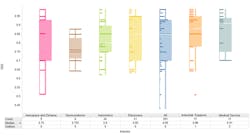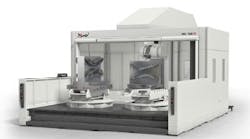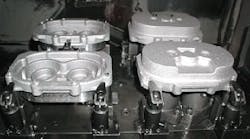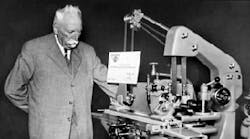In the August issue of American Machinist we recommended 12 important performance measures, with benchmark data from our 2007 Benchmark Survey, that shops should use to monitor and improve performance. [See “12 Key Performance Benchmarks,” American Machinist, August, 2007, pg. 28 and online at (www.americanmachinist.com). Those 12 measures provide a balanced mixture of financial and operational information that every machine shop should be using in a performance-improvement program. What wasn’t covered in that article was how to use the information.
The data in that, and other related articles, is benchmark data. Its purpose is to provide shop management with comparison values, the emphasis being on comparing. Knowing that the average on-time completion rate of top shops is about 91 percent can be useful if a shop knows what its on-time completion rate is. If shop management doesn’t know what its own on-time completion rate is, then knowing what the best in the industry are doing becomes an interesting but useless factoid.
The foundation of any performance improvement program is a performance management information system, a system that provides users with relevant, timely, actionable information to enable them to make effective, performance- and profit-improving decisions. Until recently that meant manual systems with periodic hardcopy reports. The time lag between event occurrence and event reporting, along with the cumbersome and tedious format of printed reports meant users were working with last week’s or last month’s data to fix today’s operational problems. That time lag not only allowed problems to go unnoticed and unsolved for a painfully long time, but also allowed transient opportunities to be lost before they were even recognized.
Today, users no longer have to wade through reams of outdated data to find the information they need for making critical decisions and taking performance-improving actions. Technology has reached the point where critical, up-to-the-minute data can be constantly available to whomever needs it in a simple, intuitively understandable graphic format. That technology is web-based scorecards and dashboards.
Dashboards, scorecards and reports often combine elements of each other, but each one targets and supports separate levels of the business decision making process. In this article, the word dashboard means an operational dashboard, not an executive dashboard. Scorecards are a form of executive dashboard.
Dashboards monitor and measure processes while scorecards chart a business unit’s progress toward a strategic goal. Both tools can use the same data but in different ways and for different purposes.
The fuel level indicator on an automobile dashboard tells the driver how much fuel is in the fuel tank at the moment. Digital gauges can even tell average mileage and how far the automobile is likely to go before running out of fuel. Those are dashboard functions. What those gauges can’t tell the driver is how much money he spent on fuel this month compared to last month or last year at that time versus how much money he planned to spend during those periods. That is a scorecard function. A report should be used to get detailed information about every fuel purchase transaction, however, both dashboards and scorecards should allow users to drill down into that information if they want or need it.
Scorecards support the most strategic level of the business decision making process. They are used to define business strategies and to see how well the organization is doing in executing those strategies. Dashboards focus on operational goals rather than strategic objectives.
The primary form of measurement for both scorecards and dashboards is the Key Performance Indicator. A key performance indicator is a metric that is tied to a target. A metric is a numeric measurement that represents a piece of business data in a relationship to one or more dimensions. How many parts are being made is not a metric. How many parts being made per hour/shift/day is a metric. How many parts is the measurement, and per hour/shift/day (time) is the dimension it is related to.
When a metric is tied to a target it becomes a key performance indicator. How many parts per hour/shift/day are being made compared to the desired number of parts? Key performance indicators on dashboards are usually shown graphically as a ratio of actual values to target values. In this example, a simple “thermometer” chart showing the current number of parts/hour being made would have a line showing the target production rate. If current production is below that rate, the value would be shown in red. Production above the line could change color to green (in the money). The person responsible for keeping part production up can immediately see with a glance how well the shop is doing at any particular time. If it is running below the desired rate, then he needs either a more detailed view of the metric (i.e. parts per machine/operator per time unit) or to look at other related indicators to see what might be causing the slowdown (i.e. machine uptime, machine availability, etc.).
It is important that dashboards and scorecards give users the ability to drill down into or view data in other ways. While the top level of the dashboard might show the current rate of production, the operations manager might want to see production by shift or by day for the last week. Or perhaps he wants to see current production by machine or by operator. All of that information should only be a mouse click or two away from the main screen.
Data for each dashboard or scorecard key performance indicator has to come from somewhere and users need to know and understand the process that supports the key performance indicators that are used to make critical decisions. How is the data collected? When and how often? Is the data altered or summarized in any way before it is used to generate the key performance indicator graphic? The answers to those questions will help the user determine just how much trust should be put in the displayed key performance indicator.
The biggest expense in setting up dashboards or scorecards is not in their creation but in their support. Acquiring reliable, quality data in a timely and error-resistant way is expensive. It means automating data capture instead of relying on manual chicken scratches and batch data entry. If a company already has an automated data capture and reporting system that covers the processes that need to be monitored, then the cost of putting a dashboard or scorecard on top of that system is minimal. If a company does not already have such a system, then getting and implementing one has to be done before thinking about dashboards, and that is never cheap.
Until recently, most shops created their dashboards and scorecards from scratch, but in the last year or two several companies developed relatively low-cost dashboard generator software ($50,000 or less). Some of the developers of financial and nonfinancial application software are also getting on the dashboard bandwagon and are beginning to offer at least rudimentary dashboard generating modules for their main products.
When considering setting up an operational dashboard or strategic scorecard, do not be dazzled by whiz-bang software demonstrations because those demonstrations use canned data, not your operational (or missing) data. And don’t get caught up in the hype and buzz currently surrounding dashboards. They are, indeed, powerful tools if they sit atop a solid database, but without the solid data to support it, a dashboard or scorecard is worse than useless... it is misleading.
Instead of looking at the software, look at the process. Identify which indicators are really important to users, indicators that give them timely, reliable, actionable information. Consider the indicators American Machinist provided in benchmark data for last month, but also consider what information the users say they need when making their operational decisions.
Once true key performance indicators are identified, look at how, or if, the data needed to support each key performance indicator is available. It is not unusual for companies to discover that the data needed to support the desired key performance indicators is not available. Too often, these companies end up using less important indicators instead of developing the data collection/storage system needed to support the key performance indicators they need to run the business. The result is not only a waste of time and of money, it can result in critical decisions being made using misleading information.
For many shop operators, setting up one more complex piece of software that does not seem directly involved in making chips can appear to be more than a waste of time, but if done right, a dashboard and scorecard combination can not only save the operator time, it can open the door to significantly improved productivity and profitability.








